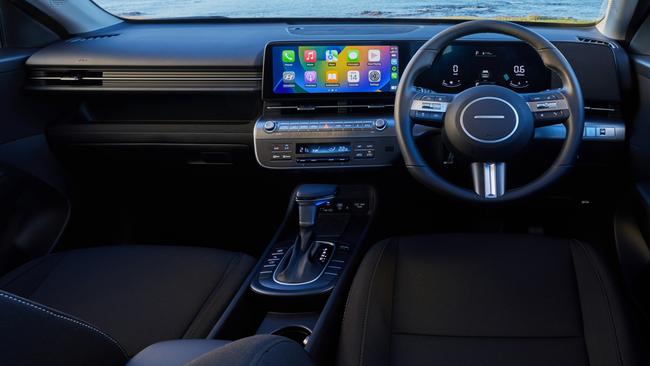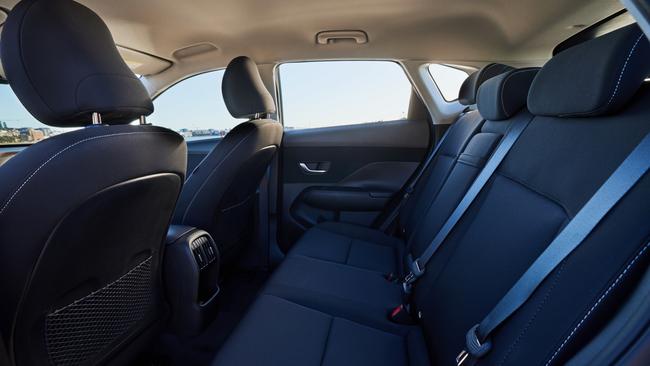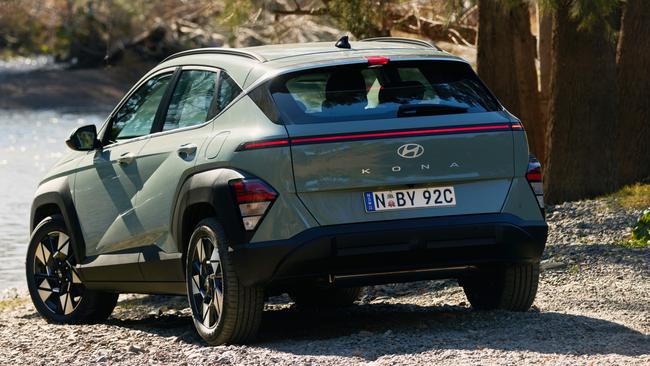Hyundai Kona review finds compact SUV now far more family friendly
Growing in every direction, Hyundai’s new Kona compact SUV has widened its appeal to a new audience.
Business
Don't miss out on the headlines from Business. Followed categories will be added to My News.
When the covers first came off Hyundai’s Kona in South Korea midway through 2017, the plan was to attract younger audiences.
Groovy colours and strong tech credentials were at the forefront. And there was no shortage of 20-something models showcasing the marketing focus.
Fast-forward to the latest generation and it’s the baby boomers who love compact SUVs – they appreciate the greater ride height for ageing bodies and can afford the asking price of at least $35,000.
That sticker is about $5000 more than the model it replaces but the new Kona has grown. Taller, wider and longer, there’s now an expanse of cabin space.
Our family put the base model to the test.

WHAT WERE YOUR FIRST IMPRESSIONS?
KEL: At school pick-up, the boys thought it was electric.
GRANT: That would have been due to the unique enclosed style grille, horizontal LED strip running lights and the Ioniq 5/6-inspired profile creases.
KEL: My parents have the older model Kona, yet this latest iteration feels like a massive size up, inside and out.
GRANT: The Venue aims to fill the compact SUV slot, whereas the Kona is now more middle ground before stepping up to the Tucson. Extra rear seat and boot space makes it far more family friendly.
KEL: Absolutely, with two kids we never would have considered one before this new Kona.
GRANT: Tucsons start from just below $40k while the Kona we tested is about $35,800. With a 12.3-inch touchscreen central display and a design which links across to the
4.2-inch driver instrument cluster, the dash looks modern and uncomplicated.
KEL: Wireless phone charging was good to see for a base model, along with radar cruise control.
GRANT: There is the N Line option pack for $3500 which gets rid of the black cladding around the tyres in exchange for the same body colour, 360-degree parking camera, heated and ventilated leather/suede front seats (rear outboard pews have heating as well), Bose stereo, 12.3-inch instrument cluster, power tailgate and a blind-spot viewing system that plays a live video feed on the digital dash.

WHAT DID YOU LOVE?
KEL: Ease of operation is at the forefront for me nowadays. The Kona was simple to plug in my phone for Apple CarPlay connection, and quick access keys on the dash for the aircon rather than through a central screen which needs more clicks than is required … it just made sense.
GRANT: Hyundai has done well in that realm. The improvement in boot space was monumental. Our weekly grocery shop of about 10 bags was accommodated and I also managed to house an adult-size bike without taking a wheel off with the rear seats dropped.
KEL: Air vents in the back kept the boys cool, along with two faster charging USB-C ports – which meant no battle between the siblings.
GRANT: Most people use the phone for satnav these days, but it is good to see Hyundai has incorporated 10 years worth of map upgrades for the in-built system if you maintain dealer servicing. Paying extra can be an issue for those who prefer to use the car system for directions.

WHAT DID YOU LOATHE?
KEL: Despite being in Queensland, I still love heated seats. I think they should be standard.
GRANT: You’ve been spoiled in the past. You do need to step up to the Premium or invest in the optional pack for that function. The N Line pack is pretty good value, I think most would struggle not to tick that box.
KEL: There were also some hard plastics around the base of the doors and console.
GRANT: That’s indicative of the price point. Another frustration was the various beeps and bongs associated with the speed limit. I regularly turned off the functionality which lets you know when you’re over the speed limit or entering a new zone. The only option was to turn off the alerts that then paused the functionality so the driver no longer can see the posted limit in their instruments.

HOW WAS THE DRIVE?
KEL: Predictable and smooth, the performance wasn’t quick nor slow.
GRANT: Economical and honest, the 2.0-litre four-cylinder engine would suit most daily drivers. There is a turbocharged 1.6-litre and a hybrid, option, while an electric option will soon be available. The turbo and EV will be the choices of those chasing extra oomph.
KEL: Overall ride quality of the Kona was good, I found it comfortable and an easy thing to live with for daily family duties.
GRANT: Using a continuously variable transmission, it does the job well and as long as you’re not ringing the four-potter’s neck it delivers linear acceleration. The handling is also well mannered with responsive steering in all conditions.

WOULD YOU BUY ONE?
KEL: With two growing teenage boys involving constant running around, the vastly improved space now makes the Kona a genuine family option. The base model felt slightly underwhelming in terms of features, so I’d definitely try to extend to the N Line option to include the gear I love most.
GRANT: Plug and play. There is nothing complicated about the Kona with the 2.0-litre engine. Easy to live with and adequate performance for the majority of drivers, it’s a top-notch value equation – Hyundai just needs to fix the constant annoying speed zone beeping.
Originally published as Hyundai Kona review finds compact SUV now far more family friendly




